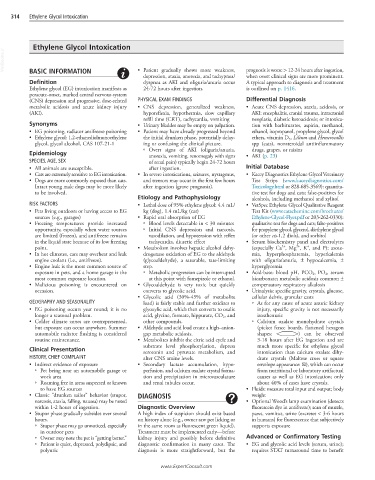Page 686 - Cote clinical veterinary advisor dogs and cats 4th
P. 686
314 Ethylene Glycol Intoxication
Ethylene Glycol Intoxication
VetBooks.ir
• Patient gradually shows more weakness,
BASIC INFORMATION
depression, ataxia, anorexia, and tachypnea/ prognosis is worse > 12-24 hours after ingestion,
when overt clinical signs are more prominent.
Definition dyspnea as AKI and oliguria/anuria occur A typical approach to diagnosis and treatment
Ethylene glycol (EG) intoxication manifests as 24-72 hours after ingestion. is outlined on p. 1416.
peracute-onset, marked central nervous system
(CNS) depression and progressive, dose-related PHYSICAL EXAM FINDINGS Differential Diagnosis
metabolic acidosis and acute kidney injury • CNS depression, generalized weakness, • Acute CNS depression, ataxia, acidosis, or
(AKI). hyporeflexia, hypothermia, slow capillary AKI: encephalitis, cranial trauma, intracranial
refill time (CRT), tachycardia, vomiting neoplasia, diabetic ketoacidosis; or intoxica-
Synonyms • Urinary bladder may be empty on palpation. tion with barbiturates, aspirin, methanol,
• EG poisoning, radiator antifreeze poisoning • Patient may have already progressed beyond ethanol, isopropanol, propylene glycol, glycol
• Ethylene glycol: 1,2-ethanediolmonoethylene the initial drunken phase, potentially delay- ethers, vitamin D 3 , Lilium and Hemerocallis
glycol, glycol alcohol, CAS 107-21-1 ing or confusing the clinical picture. spp (cats), nonsteroidal antiinflammatory
○ Overt signs of AKI (oliguria/anuria, drugs, grapes, or raisins
Epidemiology anorexia, vomiting, renomegaly with signs • AKI (p. 23)
SPECIES, AGE, SEX of renal pain) typically begin 24-72 hours
• All animals are susceptible. after ingestion. Initial Database
• Cats are extremely sensitive to EG intoxication. • In severe intoxications, seizures, nystagmus, • Kacey Diagnostics Ethylene Glycol Veterinary
• Dogs are more commonly exposed than cats. and tremors may occur in the first few hours Test Strips (www.kaceydiagnostics.com/
Intact young male dogs may be more likely after ingestion (grave prognosis). Toxicology.html or 828-685-3569): quantita-
to be involved. tive test for dogs and cats; false-positives for
Etiology and Pathophysiology alcohols, including methanol and xylitol
RISK FACTORS • Lethal dose of 95% ethylene glycol: 4.4 mL/ • VetSpec Ethylene Glycol Qualitative Reagent
• Pets living outdoors or having access to EG kg (dog), 1.4 mL/kg (cat) Test Kit (www.catacheminc.com/brochures/
sources (e.g., garages) • Rapid oral absorption of EG Ethylene-Glycol-Flyer.pdf or 203-262-0330):
• Freezing temperatures provide increased ○ Blood levels detectable in < 30 minutes qualitative test for dogs and cats; false-positives
opportunity, especially when water sources ○ Initial CNS depression and narcosis, for propylene glycol, glycerol, diethylene glycol
are limited (frozen), and antifreeze remains vasodilation, and hypotension with reflex (or other cis-1,2 diols), and sorbitol
in the liquid state because of its low freezing tachycardia, diuretic effect • Serum biochemistry panel and electrolytes
2+
2+
+
point. • Metabolism involves hepatic alcohol dehy- (especially Ca , Mg , K , and P): azote-
• In hot climates, cars may overheat and leak drogenase oxidation of EG to the aldehyde mia, hyperphosphatemia, hyperkalemia
engine coolant (i.e., antifreeze). (glycoaldehyde), a saturable, rate-limiting with oliguria/anuria, ± hypocalcemia, ±
• Engine leak is the most common source of step. hyperglycemia
exposure in pets, and a home garage is the ○ Metabolic progression can be interrupted • Acid-base: blood pH, PCO 2 , PO 2 , serum
most common exposure location. at this point with fomepizole or ethanol. bicarbonate; metabolic acidosis common ±
• Malicious poisoning is encountered on • Glycoaldehyde is very toxic but quickly compensatory respiratory alkalosis
occasion. converts to glycolic acid. • Urinalysis: specific gravity, crystals, glucose,
• Glycolic acid (30%-45% of metabolite cellular debris, granular casts
GEOGRAPHY AND SEASONALITY load) is fairly stable and further oxidizes to ○ As for any cause of acute anuric kidney
• EG poisoning occurs year round; it is no glyoxylic acid, which then converts to oxalic injury, specific gravity is not necessarily
longer a seasonal problem. acid, glycine, formate, hippurate, CO 2 , and isosthenuric
• Colder climate zones are overrepresented, other compounds. ○ Calcium oxalate monohydrate crystals
but exposure can occur anywhere. Summer • Aldehyde and acid load create a high–anion- (picket fence boards, flattened hexagon
automobile radiator flushing is considered gap metabolic acidosis. shapes: ) can be observed
routine maintenance. • Metabolites inhibit the citric acid cycle and 3-18 hours after EG ingestion and are
substrate level phosphorylation, depress much more specific for ethylene glycol
Clinical Presentation serotonin and pyruvate metabolism, and intoxication than calcium oxalate dihy-
HISTORY, CHIEF COMPLAINT alter CNS amine levels. drate crystals (Maltese cross or square
• Indirect evidence of exposure • Secondary lactate accumulation, hypo- envelope appearance: ⊠), which can occur
○ Pet being near an automobile garage or perfusion, and calcium oxalate crystal forma- from nutritional or laboratory artifactual
work area tion and precipitation in microvasculature causes as well as EG intoxication; only
○ Roaming free in areas suspected or known and renal tubules occur. about 40% of cases have crystals.
to have EG sources • Fluids: measure total input and output; body
• Classic “drunken sailor” behavior (stupor, DIAGNOSIS weight
narcosis, ataxia, falling, nausea) may be noted • Optional Wood’s lamp examination (detects
within 1-2 hours of ingestion. Diagnostic Overview fluorescein dye in antifreeze); scan of muzzle,
• Stupor phase gradually subsides over several A high index of suspicion should exist based paws, vomitus, urine (excretes < 3-6 hours
hours. on history alone (e.g., owner saw pet licking or in humans) for fluorescence that subjectively
○ Stupor phase may go unnoticed, especially in the same room as fluorescent green liquid). supports exposure
in outdoor pets Treatment must be implemented early—before
○ Owner may note the pet is “getting better.” kidney injury and possibly before definitive Advanced or Confirmatory Testing
○ Patient is quiet, depressed, polydipsic, and diagnostic confirmation in many cases. The • EG and glycolic acid levels (serum, urine);
polyuric diagnosis is more straightforward, but the requires STAT turnaround time to benefit
www.ExpertConsult.com

